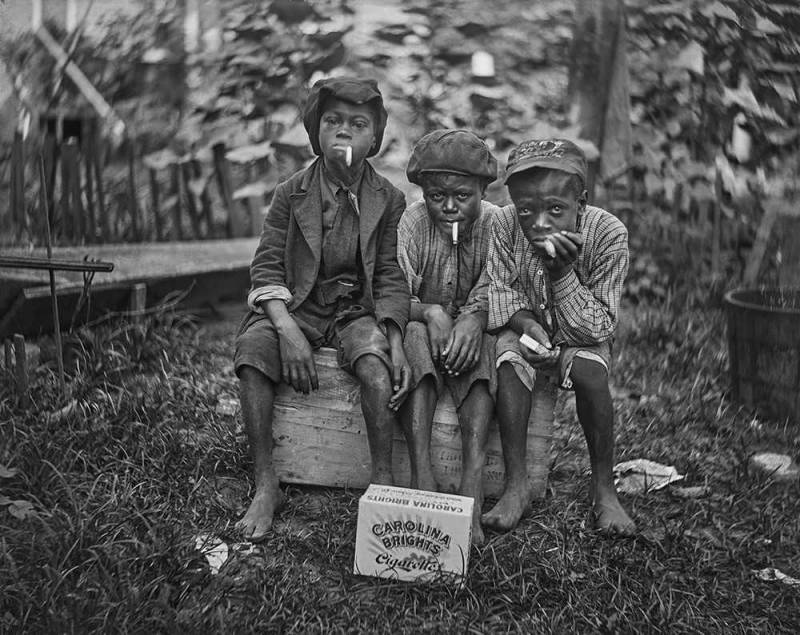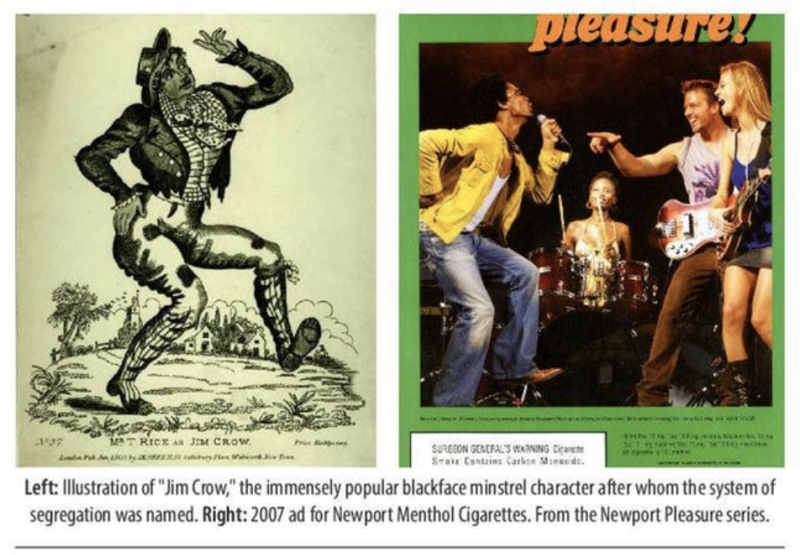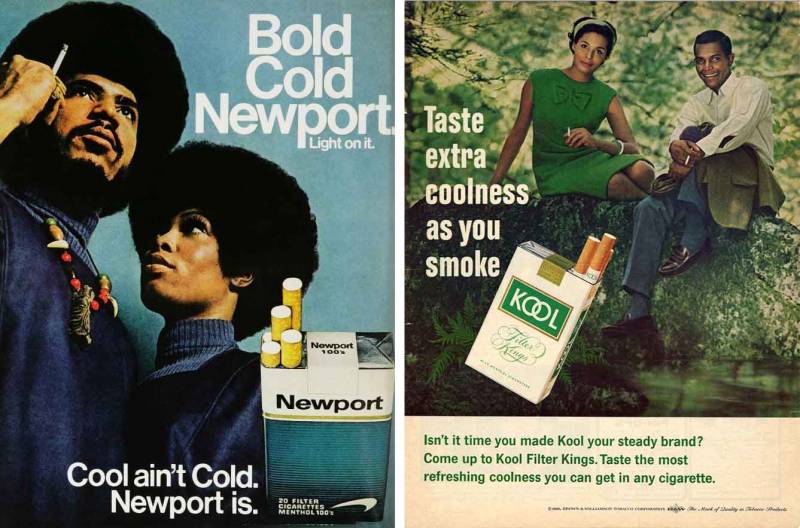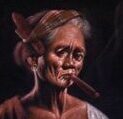Pendarvis HarshawDec 5, 2019
I want to share this article I found on KQED ARTS https://www.kqed.org/arts/13870538/the-black-community-a-target-for-the-tobacco-industry-since-slavery

“Children smoking Carolina Brights.” Photo by Bayard Wootten (“Children smoking Carolina Brights.” Photo by Bayard Wootten)
Have you ever looked at the Center for Disease Control’s web page that highlights the tobacco industry’s impact on African Americans? It’s horrifying.

According to the data, black folks say they want to quit smoking more than other demographic, but fail more often. We are more readily exposed to second hand smoke than other groups. And we live in communities where smoking advertisements disproportionately saturate the market—especially ads for menthols.
And in big bold letters, in the middle of the page, it says, “Tobacco use is a major contributor to the three leading causes of death among African Americans—heart disease, cancer, and stroke.”
Yeah, the numbers are up to date. And at the same time, this issue isn’t anything new. It’s been like this for ages. Some might say it’s been like this since our ancestors were enslaved on the tobacco farms in the Carolinas.
“I’m looking at it from slavery to vaping,” says Tracy Brown, lead artist and curator of the Same Game Different Smokers, an exhibition sponsored by The African American Tobacco Contol Leadership Council (AATCLC) and the African American Center at the San Francisco Library, which is running at the San Francisco Main Library from Dec. 7 through the first week of February.

An exhibition about the tobacco industry preying on African Americans isn’t new—there have been many others. But many of them look at the 1950s and ’60s, according to Brown. “I make the case that the tobacco industry has been targeting the black community since the 1600s,” she says.
Brown uses archival images, depictions of black people from the last decade as well as from the last century. She compares the posture of people in the photos, combines that with data collected from industry documents, and shows it all as evidence why 45,000 African Americans die from smoking every year.
But Brown, who works with the African American Tobacco Control Leadership Council, says San Francisco’s recent passage of legislation banning the sale of e-cigarettes is a glimmer of hope, and may be a sign that Big Tobacco is losing control.
A New Exhibition Sheds Light On How Big Tobacco Targeted Generations Of Black Americans
KQED’s Brian Watt visited Same Game Different Smokers, an exhibition at the San Francisco Public Library that sheds light on how big tobacco companies have historically preyed on African American communities. Tap play above to listen to the segment.
She adds it’s unfortunate that change has been spawned by headline after headline of vaping deaths, largely in white communities. But maybe it’ll open the conversation to smoking’s impacts, past and preset, on the black community.
“We know that menthol products have been used to target the black community,” says Brown. “The makers of Newport, for example.”
According to the CDC, “Over 7 out of 10 African American youth ages 12-17 years who smoke use menthol cigarettes.”
I asked the dumb question that needed to be asked: why do black folks like menthol?
Brown says, “We tend to lean toward menthol, not because of a natural inclination, but what happens with menthol when you smoke it. It sweetens the taste of tobacco, cools down and numbs your mouth and throat. The kids like menthol and mint flavors.”
But the black community isn’t unique in liking menthol products, says Brown. “What’s unique is the tobacco industry using JET magazine and Ebony, and attaching them to images of us that are very attractive.”

There was a time when I smoked menthols as a teen. But during that short stint, on one fateful day, I put a partially lit Newport into my pants pocket while rushing to jump the 58 bus in downtown Oakland. Yup, that’s all it took for me to kick the habit.
Some people aren’t as lucky to feel the pain of smoking so acutely. For most of my friends, at this age, it’s habitual. But at one time, I recall them telling me it was about a feeling, or just about access, or simply an aesthetic thing.
Brown says that aesthetic—that attractive image, which the big tobacco companies successfully sold—was strategic. But it goes beyond advertising. “They sponsored events, they work with black leaders… the tobacco industry has been very cunning in getting support of the black community,” says Brown.
There are reportedly documents that show that show tobacco companies, like Phillip Morris, have been “engaged” with the NAACP the National Urban League and The United Negro College Fund since the 1950s.
Prior to doing any research, Brown already presumed the people who run the industry were “shiesty.” Digging into old reports and data confirmed that assumption, and talking to people about firsthand experiences brought further revelations about the size of the tobacco industry’s target on the black community.
“One guy told me his mom would leave a lit cigarette in each room so she’d have something to smoke as she walked thru the house,” says Brown.
She’s been impacted by smoking on a personal level, too. She’s lost six close family members from tobacco. “One of my favorite aunts died this year,” she says, “and she was a chain smoker.”
She told me her aunt’s name was Victoria—Aunt Vicky—who loved gardening and watching movies, “and she could talk mess with the best of them,” said Brown, who used to visit her all the time in Florida.
Brown says she has family roots down there, as well as Mississippi and South Carolina. She’s traced her lineage, and has found the family that enslaved her paternal grandfather’s side. “My great-great-great grandfather was able to buy the land.”
Of course, it was “40 acres and a mule,” supposedly granted to formerly enslaved folks by the Freedman’s Bureau. And, of course, it was agricultural land in South Carolina—where they most likely grew tobacco.

But Brown, a proud San Francisco native, says San Francisco is doing something significant with its e-cigarette ban, hence her desire to hold the opening here. Ultimately, she wants to spread the word, bring the exhibit to other cities, get the FDA to step to the plate, and see something happen on a federal level.
At the same time, Brown isn’t waiting on elected officials. She wants families to be proactive, too. And she’s extending an invitation to all school districts to take a school trip or tell the friends and family about the exhibition. “I’ve talked to every child in my life about these products,” she says.
It’s a drastic shift from when I was a kid. Just a few decades ago, smoking was everywhere. Joe Camel was a cool-ass smoking cartoon. The fly guys all smoked in movies. There were billboards and bus benches. Not to mention ads in the corner stores—and there were stores on every corner. Hell, one of the coldest lines of all time is Richie Rich’s: “Where you from? Oakland, smokin’!“
Of course, Rich was talking about smoking marijuana. But even that usually came rolled in tobacco.
